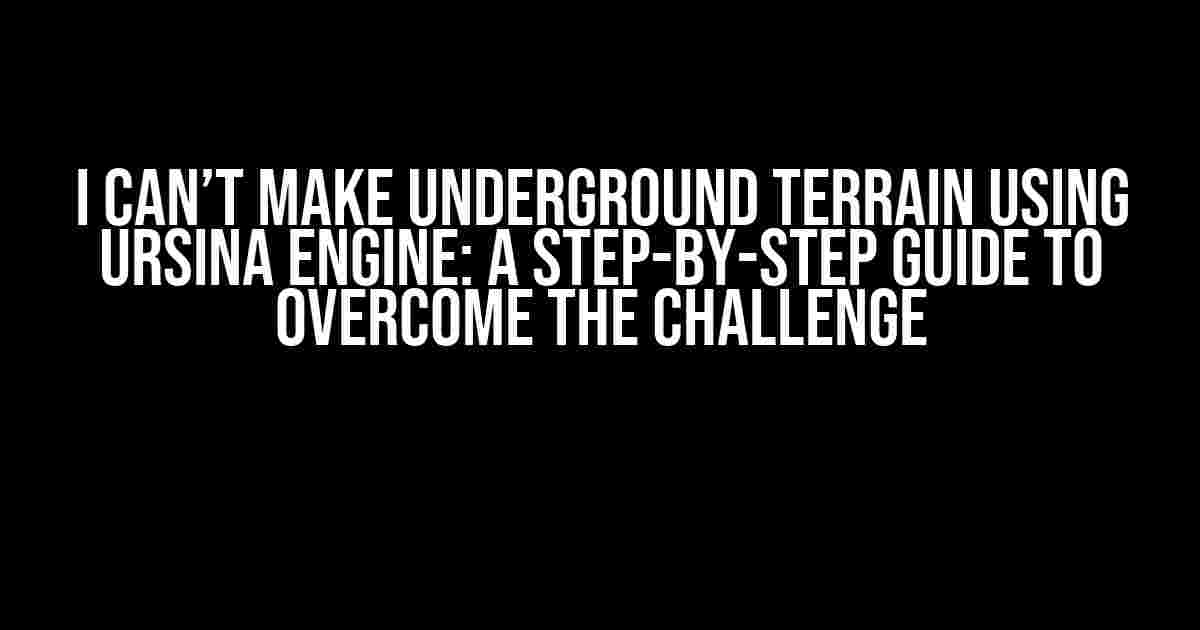Are you struggling to create underground terrain using the Ursina engine? Don’t worry, you’re not alone! Many developers have faced this challenge, and today, we’re going to tackle it head-on. In this article, we’ll take you on a journey to overcome this obstacle and create stunning underground terrain using Ursina.
Understanding the Ursina Engine
Before we dive into the solution, let’s quickly recap what Ursina is and how it works. Ursina is a Python-based game engine that allows developers to create 3D games and simulations with ease. It’s built on top of the Panda3D game engine and provides a more Pythonic API. Ursina is perfect for rapid prototyping, game development, and even architecture visualization.
The Problem: Creating Underground Terrain
So, what’s the issue with creating underground terrain in Ursina? The problem lies in the fact that Ursina’s terrain generation is primarily designed for above-ground terrain. The engine uses a heightmap-based approach to generate terrain, which makes it difficult to create underground terrain.
Symptoms of the Problem
- Your terrain looks flat and doesn’t have any depth.
- You can’t seem to create caves or underground structures.
- Your terrain generation is slow or crashes due to the complexity of the underground terrain.
The Solution: Overcoming the Limitations
Fear not, dear developer! We’ve got a few tricks up our sleeve to help you create stunning underground terrain using Ursina. Follow these steps to overcome the limitations:
Step 1: Create a Heightmap with Depth
The first step is to create a heightmap that includes depth information. You can use tools like World Machine, TerrainGen, or even a 2D image editor like GIMP to create a heightmap with depth.
import numpy as np heightmap = np.array([[0.1, 0.2, 0.3], [0.4, 0.5, 0.6], [0.7, 0.8, 0.9]])
Step 2: Invert the Heightmap
Once you have a heightmap with depth, you need to invert it. This will allow Ursina to generate terrain with negative Z-values, which is essential for creating underground terrain.
inverted_heightmap = -heightmap
Step 3: Create a Mesh with Negative Z-Values
In this step, you’ll create a mesh using the inverted heightmap. This mesh will have negative Z-values, which will allow you to create underground terrain.
from ursina import Mesh mesh = Mesh(vertices=inverted_heightmap, triangles=[], normals=[])
Step 4: Add Cave Entrances and Exits
To create a seamless underground terrain, you’ll need to add cave entrances and exits. These will allow the player to transition smoothly between above-ground and underground terrain.
from ursina import Entity cave_entrance = Entity(model='cube', scale=(1, 1, 1), position=(0, 0, 0)) cave_exit = Entity(model='cube', scale=(1, 1, 1), position=(10, 0, 0))
Step 5: Add Lighting and Textures
The final step is to add lighting and textures to your underground terrain. This will give it a realistic look and feel.
from ursina import DirectionalLight light = DirectionalLight(type='irectional', color=(1, 1, 1), position=(0, 0, 0))
Common Pitfalls and Troubleshooting
While creating underground terrain in Ursina can be challenging, there are some common pitfalls to watch out for:
- Inconsistent Heightmap Data**: Make sure your heightmap data is consistent and has the correct depth information.
- Inverted Heightmap Issues**: Double-check that your heightmap is correctly inverted to allow for negative Z-values.
- Mismatched Mesh and Heightmap Resolution**: Ensure that your mesh and heightmap resolutions match to avoid deformations and issues.
Conclusion
Creating underground terrain in Ursina may seem daunting, but with these steps, you can overcome the limitations and create stunning underground environments. Remember to be patient, and don’t hesitate to experiment and try new approaches. Happy coding!
| Step | Description |
|---|---|
| 1 | Create a heightmap with depth |
| 2 | Invert the heightmap |
| 3 | Create a mesh with negative Z-values |
| 4 | |
| 5 | Add lighting and textures |
By following these steps and troubleshooting common pitfalls, you’ll be well on your way to creating immersive underground terrain in Ursina. Don’t forget to share your creations with the community and show off your skills!
- Ursina Engine Documentation: https://ursina.io/docs/
- Ursina Community Forum: https://forum.ursina.io/
- Heightsmap Generation Tools: https://world-machine.com/, https://www.terraingen.com/
Frequently Asked Question
Stuck in Ursina Engine? Don’t worry, we’ve got you covered! Here are some frequently asked questions about creating underground terrain using Ursina Engine:
Why can’t I create underground terrain in Ursina Engine?
Ursina Engine is primarily designed for creating 3D worlds, and its default settings aren’t optimized for underground terrain creation. However, there are workarounds and tweaks you can apply to achieve the desired effect. Stay tuned for more tips!
Do I need to use a specific shader for underground terrain?
Yes, you’ll need to use a custom shader that can handle underground lighting and textures. You can either create your own shader or use pre-made ones available online. We recommend checking out the Ursina Engine community resources for inspiration!
How do I create a cave-like entrance for my underground terrain?
To create a cave-like entrance, you can use a combination of 3D modeling and terrain manipulation techniques. Try using Ursina Engine’s terrain tools to create a natural-looking entrance, and then add details like rocks, vines, and water effects to give it a more realistic look!
Can I use Ursina Engine’s built-in terrain generator for underground terrain?
While Ursina Engine’s built-in terrain generator is amazing for creating above-ground terrain, it’s not ideal for underground terrain. You’ll need to use custom scripts and plugins to generate the desired underground landscape. Don’t worry, we’ve got some tips and resources to help you get started!
What are some essential features to include in my underground terrain?
When creating underground terrain, don’t forget to include features like variable lighting, atmospheric effects, and realistic textures. You can also add interactive elements like hidden paths, secret areas, and mysterious creatures to make your underground world more immersive and engaging!
